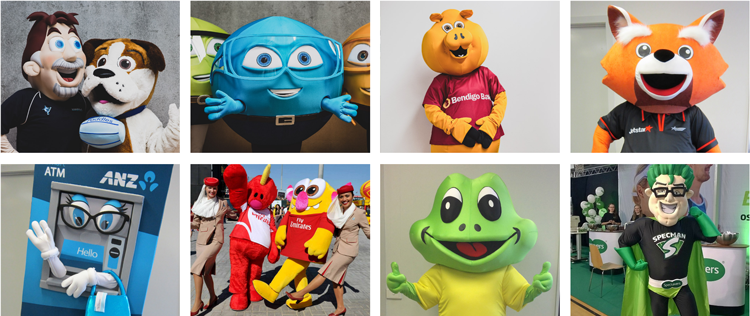Having the right promotional company mascot, whether it’s an individual, brand character or an inanimate object, does assist consumers in identifying with you and the company ethos.
It is not, however, just a question of deciding what sort of mascot you want to have and then adding images to your letterhead or company signage. First of all, you need to understand the importance of a mascot and the impact it has on the human psyche, before you can start to maximise the benefits it has for your company.
Identification and Connection
A mascot does appeal to individuals because they are memorable, a visual aid that encompasses everything about the business from its ethos to its style and quality of product and service. It can do this in the blink of an eye, so a customer doesn’t have to think too much but can take in a lot of information at a glance.
If the mascot is a character or fun to look at and watch, then it will grab the attention. Anything that makes us smile is something we want to return to again and again. If it’s something people can identify with, that is even better, and we do this by giving human characteristics to non-human items. Think about the Kellogg’s cereal campaign that came with Tony the Tiger’s endorsement.
Look around the supermarket today and see how many food items come with cartoon animals as the key mascot. Armed with collectibles, fun TV advertising and a catchy jingle, these products do have a tendency to stay at the forefront of your mind when thinking what to have for breakfast, for instance.
Getting the Right Mascot Is Key
In order to maximise the potential of your mascot, you do need to have a strong belief in the fact that brand recognition is going to be critical for your business. The starting point is to ensure that you have the right mascot, one that fits in with the ethos and culture of your organisation.
The Australian Olympic Committee recognised this back in the 1980’s when they bought the rights to “BK”. At the London 2012 Olympics, the Boxing Kangaroo was synonymous with the Aussie “have-a-go” characteristic, and symbolised Australia’s confident approach to sport.
You and everyone in your organisation have to understand that a mascot is an extension of the business. It has to represent the company so it has to reflect all aspects of the organisation, even down to the colour and size, and you may need to call in external designers to assist with this. Your mascot should also be built around the demographic of your customer base in order to be successful, so check this out and, if it isn’t, maybe it is time for a refresh.
Buy in from Your Staff
Your staff will need to endorse the company mascot and understand the reasons behind the choice and what it stands for, so make sure they are onboard and part of any refresh or consultation. You need to ask yourself and your team if your brand mascot acts in the way that you would want a company spokesperson to act. If the team buy into the brand mascot, this enables them to sell the concept of the company.
Remember, when it comes to promotional events they will be supporting the mascot either through corporate clothing, promotional materials or part of an online social media presence. If they don’t believe in it, this will get through to the customer base.
Social Media and the Company Mascot
This is the one area you cannot afford to ignore, because brand mascots have been seen to be more effective than celebrities (and a lot cheaper!). A study carried out by Synthesio found that on average, a brand mascot generated more of a social media “buzz” than endorsements by celebrities. There are also more shares on Facebook through brand mascots compared to non-character shares, such as photographs for instance.
In order to maximise the promotional benefits of your company mascot, you need to consider setting them up with their “own” Facebook page, Instagram account, and so on. Telling a story through a mascot and engaging with their “fans” has proved incredibly successful for the likes of the M&M characters, who have over 10 million Facebook fans. It is important to stay in character. This is difficult if you have several people involved in running the social media campaign, but if you don’t then you risk making a mistake and losing any success you have built up.
Of course all this needs to be part of your marketing plan and objectives as you personify the brand. You need to decide on what qualities the mascot represents, its likes and dislikes, and other personality traits. Making sure that there is humour embedded in the mascot is key because this makes the character memorable.
Engage with Your Clients
Whichever sector your brand represents, use your mascot to share hints and tips online by creating a unique hashtag. The Travelocity Gnome who roams across the globe generates a lot of social media buzz with the hashtag #GnomeWisdom. You will need to ensure that you are generating some high quality content that is unique to your organisation using the hashtag. If you get this right, your brand mascot can direct online traffic to your website and at the same time help you in brainstorming content/feedback you can use for your content calendar.
Make It Enjoyable (and Profitable)
Customers can download the highly successful Gecko ringtone and buy merchandise from the Gecko site. CompareTheMarket.com in the UK came up with the CompareTheMeerkat.com advertising campaign (an easy mistake to make) but people are buying the insurance so they can get the highly collectible Meerkat characters. They are even considering a Meerkat movie, but the point is if you have a great brand mascot that can be turned into merchandise that people are keen to have, you are on to a winner.
